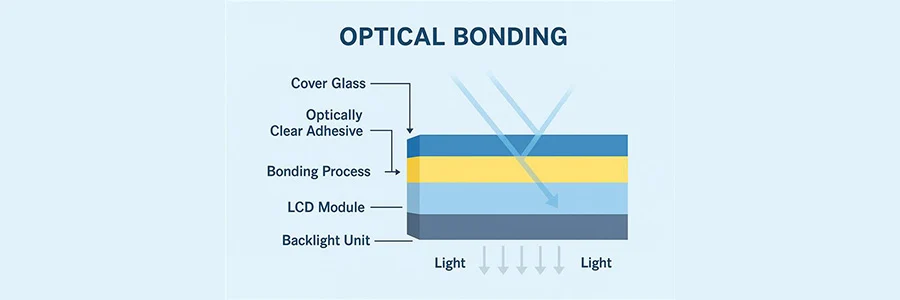
Industrial environments require reliable display performance under extreme conditions, particularly when operations are conducted outdoors. Readability in direct sunlight is a must, but not all LCDs are easily readable outdoors in the sun due to glare, shadowing, and reflection.
Optical bonding solves these challenges by removing the air gap between the LCD panel and the cover glass, creating ultra-rugged displays for direct sunlight environments. This technology not only increases readability, but it also increases the overall durability and life of the unit. This is very important for industrial and military applications where failure is not an option.
Optical bonding involves applying an optically clear adhesive between the LCD module and cover glass, effectively laminating the layers into a single, solid unit.
By filling the air gap, the adhesive prevents internal reflections that occur when light refracts between layers. This procedure often includes anti-reflective coatings over the bonded glass to eliminate glare and increase contrast. The result is an industrial display that provides clear and bright images under direct sunlight.
One of the most important benefits of optical bonding is improved visibility in direct sunlight. In unbonded monitors, ambient light can be reflected from the air gap and glass surface, producing glare that washes or obscures the image.
By bonding displays, light can travel more directly through them so that losses due to reflection are minimized. Studies show that optical bonding can increase the contrast ratio by 400% in sunlight when combined with suitable anti-reflective treatments.
This big jump in contrast means important information is still legible regardless of whether the screen is used inside a brightly lit mobile command post, outdoor workstation, or fieldstation.
Reduced glare and reflection are equally vital for outdoor operations. When sunlight or artificial light strikes a non-bonded screen, refraction within the air gap can bounce light back to the viewer as a distracting glare.
Optical bonding eliminates this air gap, allowing external light to be absorbed into the display rather than scattered. This is done to decrease eye fatigue over prolonged use and to improve visibility, obviously. Applications like marine navigation, field diagnostics, and transportation logistics value displays that stay readable under a wide range of lighting conditions.
Bonded displays are extremely durable and rugged by nature. The optically clear resin layer itself serves as a buffer layer for improving impact, vibration, and pressure resistance. Should the cover glass break, shards adhere to the adhesive layer, minimizing the risk of injury and protecting internal components.
This added resilience makes bonded displays well-suited for harsh environments such as manufacturing plants, outdoor installations, and defense operations. With the added strength to the display from the bonded glass, optical bonding increases the lifespan of industrial monitors and lowers maintenance costs.
Condensation can severely impair visibility on non-bonded screens, especially when devices transition between temperature extremes or high-humidity environments. Humidity can seep into the air gap and generate fog on the inner glass, which would block the display.
Optical bonding eliminates this gap, preventing water vapor from entering and avoiding fogging altogether. This is especially useful when deployed outdoors in rainy, coastal, or maritime environments, where conditions change rapidly. Bonded displays ensure constant visibility for continuous operation in high-stakes applications.
Optical bonding also provides better touch accuracy for touch-sensitive industrial displays. In non-bonded touch screens, there is parallax, wherein the perceived touch position does not accurately correspond to the actual display location due to the separation between the touch sensor and the display.
Eliminating the air gap brings the touch closer to users' fingers, enabling a more accurate touch experience.
This is crucial for user interfaces in rugged tablets, handheld scanners, and field stations where accurate data entry and control are mandatory.
Optically bonded sun-readable displays also typically have better thermal performance. Without an air gap to trap heat, bonded displays are more thermally efficient and less prone to overheating or aging in direct sunlight or high temperatures.
Lower light loss through reflected glare also means that backlight power requirements can be reduced, saving energy and extending the life of the display's LED backlight. This high efficiency reduces overall operating costs and enhances the lifetime reliability of the product's lifecycle.
Military and industrial sectors have utilized the potential of optical bonding solutions for mission-critical operations for years now. For defense applications, displays must function perfectly even in direct sunlight, at both high and low temperatures, and under mechanical stress.
Bonded screens are available on all our product lines, ensuring that vital information always remains visible. Likewise, outdoor digital signage, traffic control panels, and marine navigation equipment all require bonded displays to function flawlessly under environmental stress.
Optical bonding turns industrial-grade displays into workhorse sunlight-readable solutions that provide superior readability, durability, and touch accuracy. By eliminating glare, preventing condensation, and reinforcing the display structure, bonded screens withstand the rigors of outdoor and harsh-environment operations.
Whether deployed in a military outpost, a marine vessel, or a remote construction site, optically bonded displays ensure that critical data is always in clear view with zero condensation.
Optical bonding, as a fundamental technology, provides high benefits for applications that require reliable performance in challenging and harsh environments.
At VarTech Systems, our Project Managers—with an average of 15+ years of industry experience—are ready to customize a computer, monitor, or HMI workstation solution to meet your needs. Drawing from extensive backgrounds in manufacturing, military, oil and gas, and marine applications, they provide expert guidance throughout your project journey.
Please fill out our contact form, call us, or email us and we will connect with you shortly.

Based in Clemmons, North Carolina, VarTech Systems Inc. engineers and builds custom industrial and rugged computers, monitors, and HMIs.